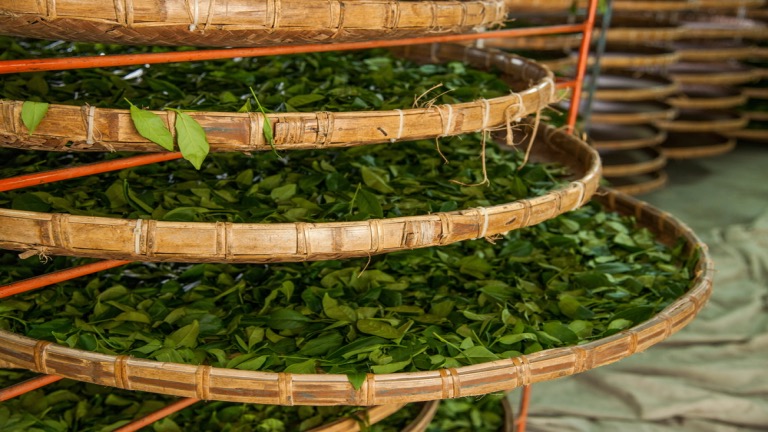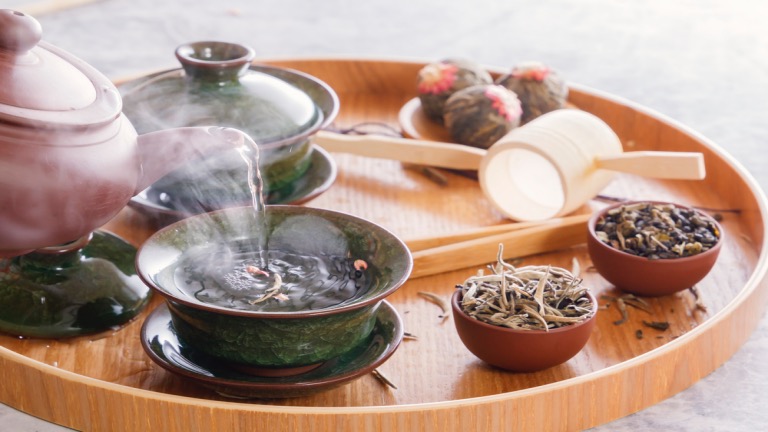Oolong tea, developed almost 400 years ago, is among the five basic types of tea, which include black tea, white tea, green tea, and Pu’er tea. Also known as Wu long tea or Wuyi tea, which translates to “black dragon tea”, it is derived from the camellia sinensis plant.
Most often, it is recognized as being somewhere in between black tea and green tea, both in terms of color and flavor. While it is commonly produced in Anxi, Wuyi, Guangdong in China and Taiwan, you can also find oolong tea from India, Thailand, New Zealand, and Japan.
Recently, oolong tea has become increasingly popular in the health and wellness world as it provides wonderful health benefits in addition to a unique and bold flavor. So if you are also looking to incorporate oolong tea as part of your daily diet, look no further! This article is your ultimate go-to guide for everything oolong!
Understanding Oolong Tea
First things first, it is important to understand that oolong tea is partially oxidized, which is what lends oolong its complex aroma and flavor. It lies on the spectrum between unoxidized green teas and completely oxidized black teas.
Oxidation is basically the process that takes place when tea leaves react with oxygen, thereby influencing the taste, appearance, and flavor of the tea. Teas that undergo less oxidation usually have a milder flavor and lighter color compared to teas that are highly oxidized.
The highest quality of oolong tea is made from mature leaves that are usually picked in late spring. The six major processes involved in preparing oolong tea leaves include the following:
- Withering – This involves sun-drying the plucked leaves so that it majorly loses its water content and gets ready for rolling or shaping. This first stage impacts the final flavor of the oolong tea.
- Bruising – The leaves are then taken indoors and tossed in bamboo trays to kickstart the partial oxidation process and other enzyme reactions. The leaves start to turn reddish-brown at this stage as they absorb oxygen.

- Fixing – This step is undertaken to stop the oxidation process by panning the tea leaves.
- Rolling – In order to develop and enhance flavor and release aromatic oils, the leaves are rolled into the shape of a ball in this fourth step.
- Drying – The leaves are then dried to eliminate moisture.
- Baking – Premium quality oolong usually involves baking, which is to dry the leaves completely in hot air drums or over charcoal. This also an additional layer of flavor and aroma complexity and usually decreases the caffeine content in oolong tea.
It is this process of partial oxidation that lends oolong its rich flavor, with bold notes of black tea combined with the earthy and woody flavor of green tea.
Common Types Of Oolong Tea You Need To Try
The process of varying levels of partial oxidation results in varying tastes and colors of oolong tea. As a rule of thumb, the darker the oolong tea, the more caffeine it will have. Additionally, oolong originating from Taiwan generally undergoes less oxidation compared to that from China.
The commonly sought-after oolong teas are the following:
- Iron Goddess of Mercy Oolong (Ti Kuan Yin) – This is one of the most famous types of oolong tea that originates from China’s Fujian province’s Anxi region. It is a slow roast oolong that has a floral taste.
- Se Chung Oolong Tea – Originating from China, it contains flavors that may remind you of green tea as it is lightly oxidized. Overall, it has an earthy flavor and beautiful aroma.
- Milk Oolong Tea (Jin Xuan Tea) – This is a Taiwanese variety that gets its name from the fact that it has a milky, buttery, creamy flavor. Most people end up adding sweeteners to it in order to enhance the taste.
- Wuyi Oolong Tea (Da Hong Pao) – Also known as “rock tea”, it is grown in the mineral-rich Wuyi mountains in China. It is highly oxidized and offers a smoky flavor. Keep in mind that this is one of the most expensive oolong teas on the market.
- Phoenix Tea (Dan Chong or Dan Cong) – Hailing from China’s Phoenix mountains in the Guangdong province, it is known for its brilliant fragrance and fruity taste with hints of woody flavors.
Health Benefits Of Consuming Oolong Tea
Oolong tea is associated with plenty of health benefits. It has many minerals, vitamins, and antioxidants such as fluoride, manganese, potassium, sodium, magnesium, niacin, caffeine, theaflavins, thearubigins and EGCG, all of which are excellent for maintaining good health and overall wellbeing.
The antioxidants in oolong tea, known as polyphenol, are associated with maintaining blood sugar levels and significantly decreasing the risk of type-2 diabetes. Studies have also shown that oolong tea is great for reducing the risk of heart disease, stroke, and even high blood pressure. It is also beneficial for maintaining brain health and preventing diseases such as Alzheimer’s.
Added to that, oolong tea has been associated with decreasing the risk of cancer such as liver, lung, pancreatic, and esophageal cancers. It is also great for promoting bone and tooth health by enhancing bone mineral density and strengthening tooth enamel, respectively. Regular consumption of oolong tea has also been linked to weight loss as it helps to burn calories and fat. Some research also suggests that it is beneficial for treating symptoms of eczema, which is a skin condition caused by inflammation.
Preparing The Perfect Cup Of Oolong Tea
Now that you know everything about how oolong tea is made and how it gets its impeccable flavors, it is time to learn how to prepare the perfect cuppa!
Brewing oolong tea depends on the level of oxidation. Generally, lightly oxidized or greener oolong varieties should be brewed at a relatively lower temperature, around 180°F, compared to heavily oxidized or darker oolongs, at around 212°F, to really bring out the flavor. 
If you can get your hands on a gaiwan, which is a traditional Chinese tea vessel used for brewing tea, that would be ideal. Otherwise, a teapot will also work.
First, boil some water and add it to the gaiwan or teapot, and then immediately discard it. This raises the temperature of the vessel to preheat it. Second, boil the water to the optimal temperature depending on the type of oolong tea you are using, and add 1 teaspoon of loose tea for every cup you brew. Add the tea leaves to the gaiwan or pot and pour the boiling water, and let it steep for 3 to 4 minutes.
Finally, pour the tea into a cup using a strainer and curl up and enjoy the warmth and flavor of the perfect cup of oolong tea.
